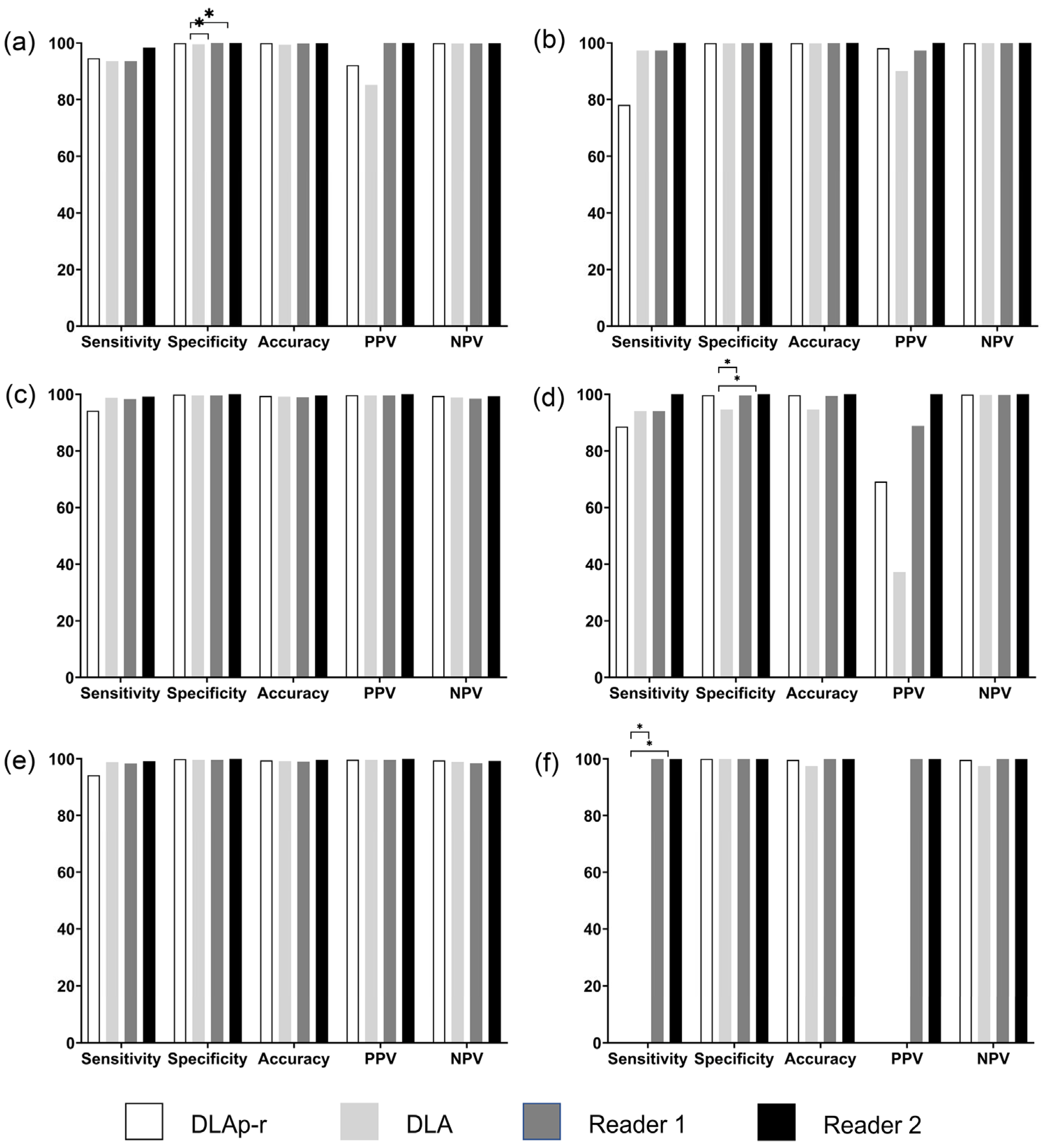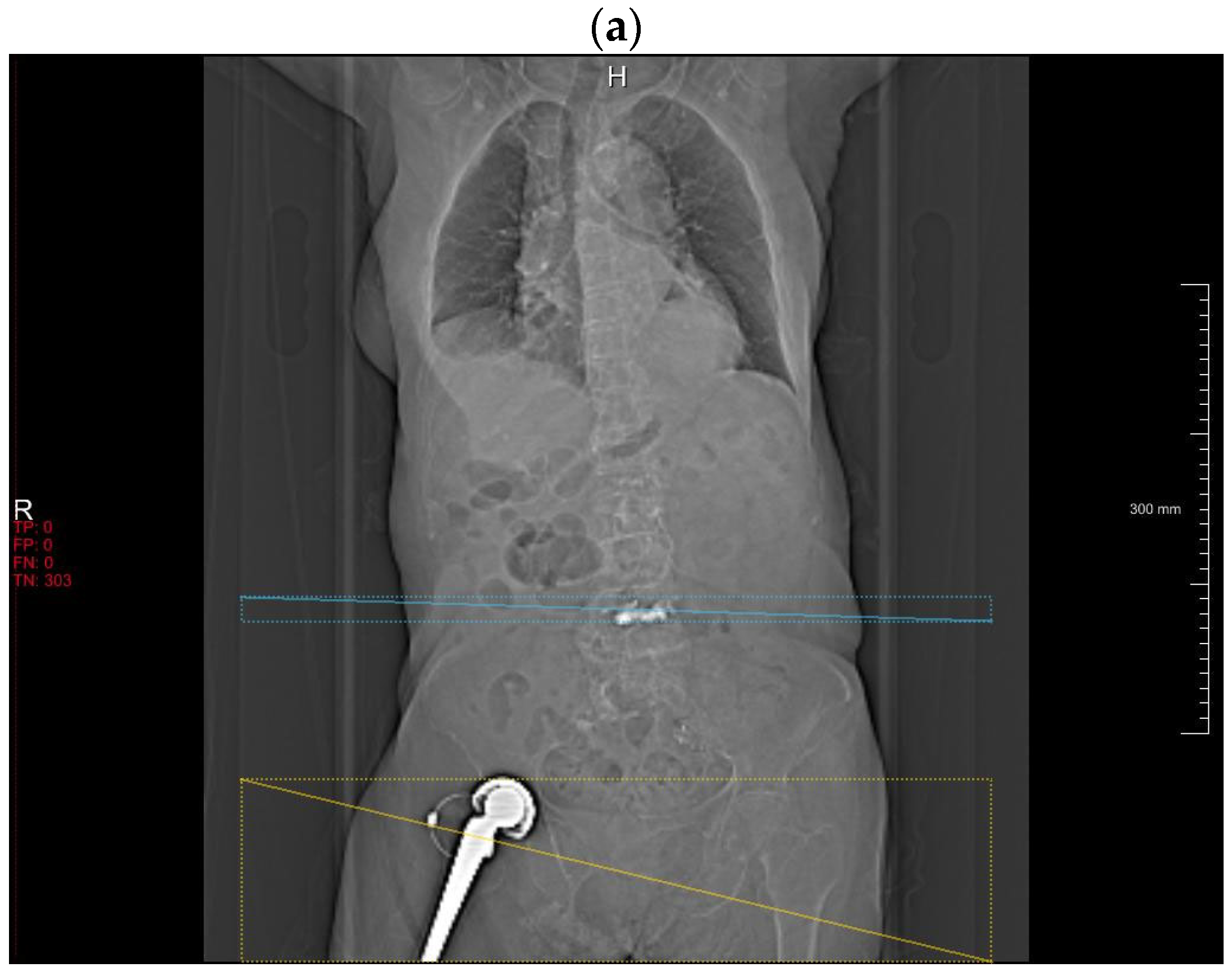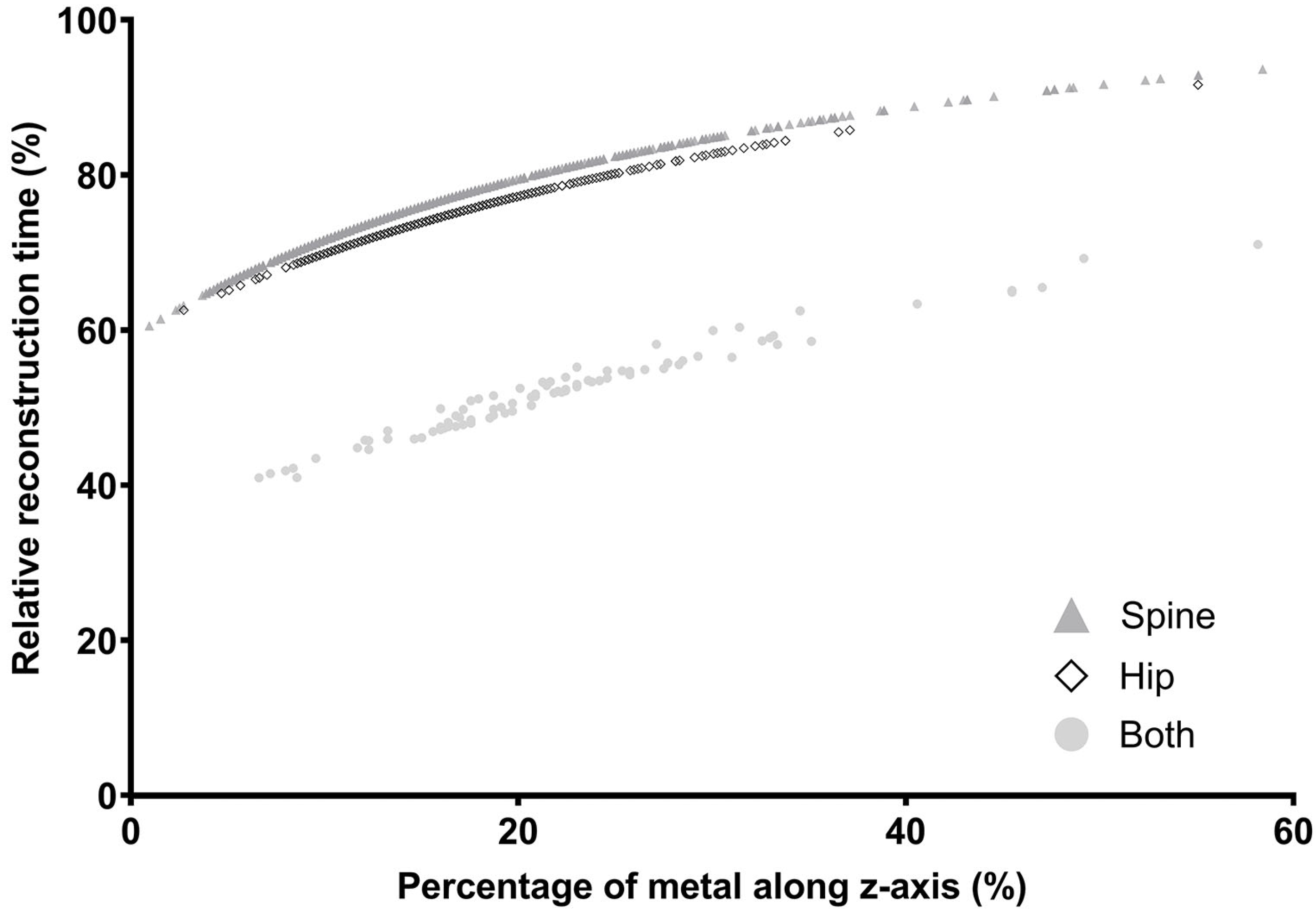Development and Validation of a Deep-Learning-Based Algorithm for Detecting and Classifying Metallic Implants in Abdominal and Spinal CT Topograms
Abstract
1. Introduction
2. Materials and Methods
2.1. Development and Validation of the DLA
2.2. External Validation of the DLA on Prototype Software
2.3. Impact on Reconstruction Time by Integrating the DLA into iMAR Process
2.4. Statistical Analysis
3. Results
3.1. Performance of the DLA during the Developmental Stage
3.2. External Validation on Prototype Software
3.2.1. Characteristics of the External Validation Dataset
3.2.2. Abdomen CT AP Tomogram
3.2.3. Spine CT AP and Lateral Topograms
3.2.4. Retrospective Observations for DLA Misclassification
3.2.5. Intersection over Unit between DLA and Radiologists
3.3. Impact on Reconstruction Time by Integrating the DLA
4. Discussion
Supplementary Materials
Author Contributions
Funding
Institutional Review Board Statement
Informed Consent Statement
Data Availability Statement
Conflicts of Interest
References
- Pabinger, C.; Geissler, A. Utilization rates of hip arthroplasty in OECD countries. Osteoarthr. Cartil. 2014, 22, 734–741. [Google Scholar] [CrossRef]
- Rajaee, S.S.; Bae, H.W.; Kanim, L.E.; Delamarter, R.B. Spinal fusion in the United States: Analysis of trends from 1998 to 2008. Spine 2012, 37, 67–76. [Google Scholar] [CrossRef]
- Roth, T.D.; Maertz, N.A.; Parr, J.A.; Buckwalter, K.A.; Choplin, R.H. CT of the hip prosthesis: Appearance of components, fixation, and complications. Radiographics 2012, 32, 1089–1107. [Google Scholar] [CrossRef]
- Stradiotti, P.; Curti, A.; Castellazzi, G.; Zerbi, A. Metal-related artifacts in instrumented spine. Techniques for reducing artifacts in CT and MRI: State of the art. Eur. Spine J. 2009, 18 (Suppl. S1), 102–108. [Google Scholar] [CrossRef]
- Ghodasara, N.; Yi, P.H.; Clark, K.; Fishman, E.K.; Farshad, M.; Fritz, J. Postoperative Spinal CT: What the Radiologist Needs to Know. Radiographics 2019, 39, 1840–1861. [Google Scholar] [CrossRef]
- Katsura, M.; Sato, J.; Akahane, M.; Kunimatsu, A.; Abe, O. Current and Novel Techniques for Metal Artifact Reduction at CT: Practical Guide for Radiologists. Radiographics 2018, 38, 450–461. [Google Scholar] [CrossRef]
- Aissa, J.; Boos, J.; Sawicki, L.M.; Heinzler, N.; Krzymyk, K.; Sedlmair, M.; Kröpil, P.; Antoch, G.; Thomas, C. Iterative metal artefact reduction (MAR) in postsurgical chest CT: Comparison of three iMAR-algorithms. Br. J. Radiol. 2017, 90, 20160778. [Google Scholar] [CrossRef]
- Aissa, J.; Thomas, C.; Sawicki, L.M.; Caspers, J.; Kropil, P.; Antoch, G.; Boos, J. Iterative metal artefact reduction in CT: Can dedicated algorithms improve image quality after spinal instrumentation? Clin. Radiol. 2017, 72, 428.e7–428.e12. [Google Scholar] [CrossRef]
- Shinohara, Y.; Ohmura, T.; Sasaki, F.; Inomata, T.; Itoh, T.; Kinoshita, T. Appropriate iMAR presets for metal artifact reduction from surgical clips and titanium burr hole covers on postoperative non-contrast brain CT. Eur. J. Radiol. 2021, 141, 109811. [Google Scholar] [CrossRef]
- Subhas, N.; Primak, A.N.; Obuchowski, N.A.; Gupta, A.; Polster, J.M.; Krauss, A.; Iannotti, J.P. Iterative metal artifact reduction: Evaluation and optimization of technique. Skelet. Radiol. 2014, 43, 1729–1735. [Google Scholar] [CrossRef]
- van der Vos, C.S.; Arens, A.I.J.; Hamill, J.J.; Hofmann, C.; Panin, V.Y.; Meeuwis, A.P.W.; Visser, E.P.; de Geus-Oei, L.-F. Metal Artifact Reduction of CT Scans to Improve PET/CT. J. Nucl. Med. 2017, 58, 1867–1872. [Google Scholar] [CrossRef]
- Lee, M.H.; Lubner, M.G.; Mellnick, V.M.; Menias, C.O.; Bhalla, S.; Pickhardt, P.J. The CT scout view: Complementary value added to abdominal CT interpretation. Abdom. Radiol. 2021, 46, 5021–5036. [Google Scholar] [CrossRef]
- Ruan, J.; Meng, Y.; Zhao, F.; Gu, H.; He, L.; Gong, X. Development of Deep Learning-based Automatic Scan Range Setting Model for Lung Cancer Screening Low-dose CT Imaging. Acad. Radiol. 2022, 29, 1541–1551. [Google Scholar] [CrossRef]
- Montoya, J.C.; Zhang, C.; Li, Y.; Li, K.; Chen, G.H. Reconstruction of three-dimensional tomographic patient models for radiation dose modulation in CT from two scout views using deep learning. Med. Phys. 2022, 49, 901–916. [Google Scholar] [CrossRef]
- Ichikawa, S.; Hamada, M.; Sugimori, H. A deep-learning method using computed tomography scout images for estimating patient body weight. Sci. Rep. 2021, 11, 15627. [Google Scholar] [CrossRef]
- Demircioglu, A.; Stein, M.C.; Kim, M.S.; Geske, H.; Quinsten, A.S.; Blex, S.; Umutlu, L.; Nassenstein, K. Detecting the pulmonary trunk in CT scout views using deep learning. Sci. Rep. 2021, 11, 10215. [Google Scholar] [CrossRef]
- Deshpande, H.; Bergtholdt, M.; Gotman, S.; Saalbach, A.; Sénégas, J. (Eds.) Deep Learning Based Segmentation of Body Parts in CT Localizers and Application to Scan Planning. In Proceedings of the 2020 IEEE 17th International Symposium on Biomedical Imaging (ISBI), Iowa City, IA, USA, 3–7 April 2020. [Google Scholar]
- Du, G.; Cao, X.; Liang, J.; Chen, X.; Zhan, Y. Medical Image Segmentation based on U-Net: A Review. J. Imaging Sci. Technol. 2020, 64, 1. [Google Scholar] [CrossRef]
- Ronneberger, O.; Fischer, P.; Brox, T. (Eds.) U-net: Convolutional networks for biomedical image segmentation. In Proceedings of the International Conference on Medical Image Computing and Computer-Assisted Intervention, Munich, Germany, 5–9 October 2015; Springer: Berlin/Heidelberg, Germany, 2015. [Google Scholar]
- Wu, P.; Sheth, N.; Sisniega, A.; Uneri, A.; Han, R.; Vijayan, R.; Vagdargi, P.; Kreher, B.; Kunze, H.; Kleinszig, G.; et al. (Eds.) Method for metal artifact avoidance in C-arm cone-beam CT. In Proceedings of the Medical Imaging 2020: Physics of Medical Imaging, Houston, TX, USA, 16–19 February 2020. [Google Scholar]
- He, K.; Zhang, X.; Ren, S.; Sun, J. (Eds.) Deep Residual Learning for Image Recognition. In Proceedings of the 2016 IEEE Conference on Computer Vision and Pattern Recognition (CVPR), Las Vegas, NV, USA, 27–30 June 2016. [Google Scholar]
- Chen, Y.; Li, Y.; Guo, H.; Hu, Y.; Luo, L.; Yin, X.; Gu, J.; Toumoulin, C. CT Metal Artifact Reduction Method Based on Improved Image Segmentation and Sinogram In-Painting. Math. Probl. Eng. 2012, 2012, 786281. [Google Scholar] [CrossRef]
- Meyer, E.; Raupach, R.; Lell, M.; Schmidt, B.; Kachelriess, M. Frequency split metal artifact reduction (FSMAR) in computed tomography. Med. Phys. 2012, 39, 1904–1916. [Google Scholar] [CrossRef]
- Pua, R.; Wi, S.; Park, M.; Lee, J.R.; Cho, S. An Image-Based Reduction of Metal Artifacts in Computed Tomography. J. Comput. Assist. Tomogr. 2016, 40, 131–141. [Google Scholar] [CrossRef]
- Long, Z.; Bruesewitz, M.R.; DeLone, D.R.; Morris, J.M.; Amrami, K.K.; Adkins, M.C.; Glazebrook, K.N.; Kofler, J.M.; Leng, S.; McCollough, C.H.; et al. Evaluation of projection- and dual-energy-based methods for metal artifact reduction in CT using a phantom study. J. Appl. Clin. Med. Phys. 2018, 19, 252–260. [Google Scholar] [CrossRef]




| Spine Implants | Hip Implants | |||
|---|---|---|---|---|
| Per Pixel Row | Per Patient | Per Pixel Row | Per Patient | |
| Sensitivity | 96.9% | 99.9% | 97.9% | 100% |
| Specificity | 99.4% | 95.6% | 99.9% | 98.4% |
| Accuracy | 99.1% | 98.6% | 99.7% | 98.9% |
| PPV | 95.9% | 98.2% | 98.2% | 96.4% |
| NPV | 99.6% | 99.8% | 99.8% | 100% |
| Abdominal CT_AP (n = 2178) | Spinal CT_AP (n = 515) | Spinal CT_Lat (n = 515) | ||||
|---|---|---|---|---|---|---|
| Projection | Anteroposterior | Anteroposterior | Lateral | |||
| Age a | 61 [51–70] | 70 [63–75] | 70 [63–75] | |||
| Sex (M:F) | 1134:1044 | 193:322 | 193:322 | |||
| b Scanner (1:2:3:4:5:6:7) | 576:253:37:562:367:73:310 | 129:87:0:77:69:11:142 | 129:87:0:77:69:11:142 | |||
| Implants | Spine | Hip | Spine | Hip | Spine | Hip |
| No. of positive cases (both) | 62 (4) | 37 (4) | 244 (10) | 17 (10) | 238 (6) | 13 (6) |
| a Craniocaudal length (number of pixels in z-axis) | 55 [34–72.5] | 84 [74–117] | 84 [62–123] | 412 [355–444] | 87 [62–124] | 62 [55–76] |
| Abdominal CT_AP | Spinal CT_AP | Spinal CT_Lat | ||||
|---|---|---|---|---|---|---|
| Spine Implants (n = 56) | Hip Implants (n = 30) | Spine Implants (n = 239) | Hip Implants (n = 15) | Spine Implants (n = 239) | Hip Implants (n = 15) | |
| DLA—Reader 1 | * 0.939 [0.927–0.950] | 0.977 [0.958–0.996] | * 0.936 [0.924–0.948] | * 0.912 [0.860–0.965] | * 0.933 [0.920–0.946] | NA |
| DLA—Reader 2 | 0.955 [0.945–0.966] | 0.966 [0.948–0.984] | * 0.947 [0.938–0.956] | * 0.914 [0.856–0.973] | * 0.931 [0.918–0.943] | NA |
| Reader 1—Reader 2 | 0.960 [0.951–0.968] | 0.978 [0.968–0.988] | 0.969 [0.961–0.978] | 0.973 [0.962–0.984] | 0.981 [0.978–0.983] | 0.983 [0.974–0.991] |
Disclaimer/Publisher’s Note: The statements, opinions and data contained in all publications are solely those of the individual author(s) and contributor(s) and not of MDPI and/or the editor(s). MDPI and/or the editor(s) disclaim responsibility for any injury to people or property resulting from any ideas, methods, instructions or products referred to in the content. |
© 2024 by the authors. Licensee MDPI, Basel, Switzerland. This article is an open access article distributed under the terms and conditions of the Creative Commons Attribution (CC BY) license (https://creativecommons.org/licenses/by/4.0/).
Share and Cite
Choi, M.-H.; Jung, J.-Y.; Peng, Z.; Grosskopf, S.; Suehling, M.; Hofmann, C.; Pak, S. Development and Validation of a Deep-Learning-Based Algorithm for Detecting and Classifying Metallic Implants in Abdominal and Spinal CT Topograms. Diagnostics 2024, 14, 668. https://doi.org/10.3390/diagnostics14070668
Choi M-H, Jung J-Y, Peng Z, Grosskopf S, Suehling M, Hofmann C, Pak S. Development and Validation of a Deep-Learning-Based Algorithm for Detecting and Classifying Metallic Implants in Abdominal and Spinal CT Topograms. Diagnostics. 2024; 14(7):668. https://doi.org/10.3390/diagnostics14070668
Chicago/Turabian StyleChoi, Moon-Hyung, Joon-Yong Jung, Zhigang Peng, Stefan Grosskopf, Michael Suehling, Christian Hofmann, and Seongyong Pak. 2024. "Development and Validation of a Deep-Learning-Based Algorithm for Detecting and Classifying Metallic Implants in Abdominal and Spinal CT Topograms" Diagnostics 14, no. 7: 668. https://doi.org/10.3390/diagnostics14070668
APA StyleChoi, M.-H., Jung, J.-Y., Peng, Z., Grosskopf, S., Suehling, M., Hofmann, C., & Pak, S. (2024). Development and Validation of a Deep-Learning-Based Algorithm for Detecting and Classifying Metallic Implants in Abdominal and Spinal CT Topograms. Diagnostics, 14(7), 668. https://doi.org/10.3390/diagnostics14070668






